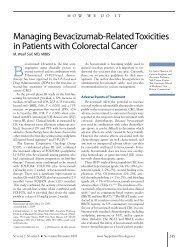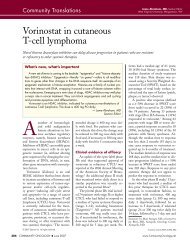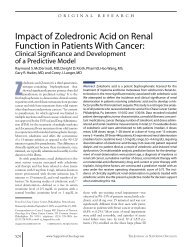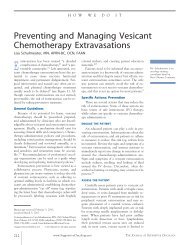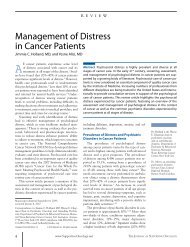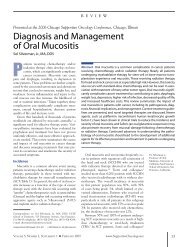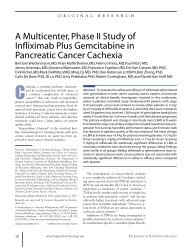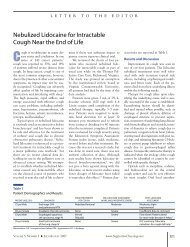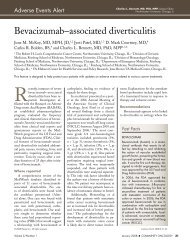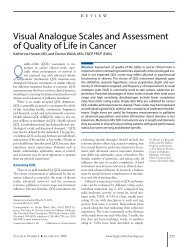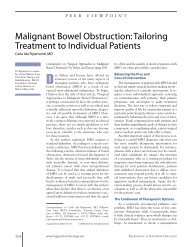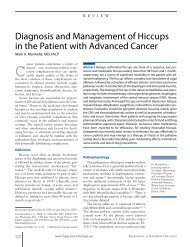Volume 9 Number 3 March 2012 - Oncology Practice Digital Network
Volume 9 Number 3 March 2012 - Oncology Practice Digital Network
Volume 9 Number 3 March 2012 - Oncology Practice Digital Network
You also want an ePaper? Increase the reach of your titles
YUMPU automatically turns print PDFs into web optimized ePapers that Google loves.
Community Translations<br />
TABLE 1 Adverse events of grade 2 or higher in<br />
patients receiving vemurafenib or dacarbazine<br />
Vemurafenib<br />
(n 336)<br />
% of patients<br />
Dacarbazine<br />
(n 282)<br />
Arthralgia<br />
Grade 2 18 1<br />
Grade 3 3 1<br />
Rash<br />
Grade 2 10 0<br />
Grade 3 8 0<br />
Fatigue<br />
Grade 2 11 12<br />
Grade 3 2 2<br />
Cutaneous squamous cell<br />
carcinoma<br />
Grade 3 12 1<br />
Keratoacanthoma<br />
Grade 2 2 0<br />
Grade 3 6 0<br />
Nausea<br />
Grade 2 7 11<br />
Grade 3 1 2<br />
Alopecia<br />
Grade 2 8 0<br />
Pruritus<br />
Grade 2 6 0<br />
Grade 3 1 0<br />
Hyperkeratosis<br />
Grade 2 5 0<br />
Grade 3 1 0<br />
Diarrhea<br />
Grade 2 5 1<br />
Grade 3 1 1<br />
Headache<br />
Grade 2 4 2<br />
Grade 3 1 0<br />
Vomiting<br />
Grade 2 3 5<br />
Grade 3 1 1<br />
Neutropenia<br />
Grade 2 1 1<br />
Grade 3 0 5<br />
Grade 4 1 3<br />
Grade 5 0 1<br />
From Chapman et al [Chapman 2011].<br />
sex, ECOG performance status, tumor stage, lactate dehydrogenase<br />
level, and geographic region. At the time of<br />
interim analysis, the number of patients with follow-up<br />
greater than 7 months was inadequate to provide reliable<br />
estimates for Kaplan-Meier survival curves. At 6 months,<br />
OS was 84% in the vemurafenib group and 64% in the<br />
dacarbazine group. Follow-up for OS is ongoing. In 549<br />
patients who were evaluated for PFS, vemurafenib was<br />
associated with a 74% reduction in risk for tumor progression<br />
(HR, 0.26; P .001). Estimated median PFS<br />
durations were 5.3 months for vermurafenib, compared<br />
with 1.6 months for dacarbazine, and superior PFS was<br />
observed for vemurafenib in all subgroups examined.<br />
Among 439 patients evaluated for tumor response, response<br />
rates were 48% in the vemurafenib group (104<br />
partial and 2 complete responses), compared with 5% (all<br />
partial responses) in the dacarbazine group (P .001).<br />
Most patients in the vemurafenib group had a detectable<br />
decrease in tumor size.<br />
Adverse events of grade 2 or higher among 618 patients<br />
included in the safety analysis are shown in the<br />
Table 1. The most common adverse events in the vemurafenib<br />
group were cutaneous events, arthralgia, and fatigue.<br />
Photosensitivity reactions of grade 2 or 3 were<br />
observed in 12% of vemurafenib patients; grade 3 reactions<br />
were characterized by blistering that could be<br />
prevented with sun block. Cutaneous squamous cell<br />
carcinoma or keratoacanthoma or both developed in 61<br />
vemurafenib patients (18%), with all lesions being<br />
treated by simple excision. Pathological analysis of skin<br />
biopsies from these patients is under way. The most<br />
common adverse events in dacarbazine patients were fatigue,<br />
nausea, vomiting, and neutropenia. Adverse events<br />
required dose modification or interruption in 38% of<br />
vemurafenib patients, compared with 16% of dacarbazine<br />
patients.<br />
The safety and efficacy of vemurafenib have not been<br />
investigated in melanoma with wild-type BRAF. The<br />
labeling for vemurafenib carries warnings and precautions<br />
for cutaneous squamous cell carcinomas, serious hypersensitivity<br />
reactions (including anaphylaxis), severe dermatologic<br />
reactions (including Stevens-Johnson syndrome<br />
and toxic epidermal necrolysis), QT interval<br />
prolongation, liver function abnormalities, photosensitivity,<br />
serious ophthalmologic reactions (including uveitis,<br />
iritis, and retinal vein occlusion), new primary malignant<br />
melanomas, and use in pregnancy.<br />
References<br />
1. Chapman PB, Hauschild A, Robert C, Haanen JB, Ascierto P,<br />
Larkin J, et al. Improved survival with vemurafenib in melanoma with<br />
BRAF V600E mutation. N Engl J Med. 2011;364(26):2507-2516.<br />
2. Zelboraf (vemurafenib) [package insert]. San Francisco, CA: Genentech<br />
USA Inc; 2011.<br />
86 COMMUNITY ONCOLOGY <strong>March</strong> <strong>2012</strong> www.Community<strong>Oncology</strong>.net



